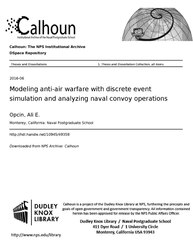File:Modeling anti-air warfare with discrete event simulation and analyzing naval convoy operations (IA modelingntiairwa1094549358).pdf

Original file (1,275 × 1,650 pixels, file size: 3.75 MB, MIME type: application/pdf, 148 pages)
Captions
Captions
Summary[edit]
| Modeling anti-air warfare with discrete event simulation and analyzing naval convoy operations
( |
||
|---|---|---|
| Author |
Opcin, Ali E. |
|
| Title |
Modeling anti-air warfare with discrete event simulation and analyzing naval convoy operations |
|
| Publisher |
Monterey, California: Naval Postgraduate School |
|
| Description |
Anti-air warfare (AAW) is a primary naval warfare area. Using AAW tactics and concepts of operations, this research explores the most critical success factors of convoy operations. In this study, a discrete event simulation (DES) was built by modeling ships, and their sensors and weapons, to simulate convoy operations under air threat. Where classified data was unavailable, assumptions were made and approximations were used in constructing the ships, weapons, and sensors. The model was used to simulate over 1.5 million naval battles varying 99 input variables using sophisticated and systematically created data combinations. To select the input settings over a specific range of input variables, a nearly orthogonal nearly balanced (NOB) Latin hypercube design was used. The effects of these input changes on the outputs were analyzed using partition trees and nominal logistic regression. The primary response variable was the survival of the High Value Unit (HVU) as a binary outcome. According to the analysis, in a convoy operation under air threat, the surface-to-air missile (SAM) specifications of the screen ships, the staying power of the HVU, and the anti-ship missile (ASM) specifications of the enemy ships had the most significant effect on the survival of the HVU. Subjects: Discrete Event Simulation; Modeling Anti-Air Warfare; Simkit; Component Based Approach; Layered Defense Systems; Formation Movements; Design of Experiments; Simulation Output Analysis |
|
| Language | English | |
| Publication date | June 2016 | |
| Current location |
IA Collections: navalpostgraduateschoollibrary; fedlink |
|
| Accession number |
modelingntiairwa1094549358 |
|
| Source | ||
| Permission (Reusing this file) |
Copyright is reserved by the copyright owner. | |
Licensing[edit]
| Public domainPublic domainfalsefalse |
This work is in the public domain in the United States because it is a work prepared by an officer or employee of the United States Government as part of that person’s official duties under the terms of Title 17, Chapter 1, Section 105 of the US Code.
Note: This only applies to original works of the Federal Government and not to the work of any individual U.S. state, territory, commonwealth, county, municipality, or any other subdivision. This template also does not apply to postage stamp designs published by the United States Postal Service since 1978. (See § 313.6(C)(1) of Compendium of U.S. Copyright Office Practices). It also does not apply to certain US coins; see The US Mint Terms of Use.
|
 | |
| This file has been identified as being free of known restrictions under copyright law, including all related and neighboring rights. | ||
https://creativecommons.org/publicdomain/mark/1.0/PDMCreative Commons Public Domain Mark 1.0falsefalse
File history
Click on a date/time to view the file as it appeared at that time.
| Date/Time | Thumbnail | Dimensions | User | Comment | |
|---|---|---|---|---|---|
| current | 01:48, 23 July 2020 |  | 1,275 × 1,650, 148 pages (3.75 MB) | Fæ (talk | contribs) | FEDLINK - United States Federal Collection modelingntiairwa1094549358 (User talk:Fæ/IA books#Fork8) (batch 1993-2020 #22200) |
You cannot overwrite this file.
File usage on Commons
The following page uses this file:
Metadata
This file contains additional information such as Exif metadata which may have been added by the digital camera, scanner, or software program used to create or digitize it. If the file has been modified from its original state, some details such as the timestamp may not fully reflect those of the original file. The timestamp is only as accurate as the clock in the camera, and it may be completely wrong.
| Short title | Modeling anti-air warfare with discrete event simulation and analyzing naval convoy operations |
|---|---|
| Author | Opcin, Ali E. |
| Software used | Opcin, Ali E. |
| Conversion program | Acrobat Distiller 11.0 (Windows) |
| Encrypted | no |
| Page size | 612 x 792 pts (letter) |
| Version of PDF format | 1.4 |

